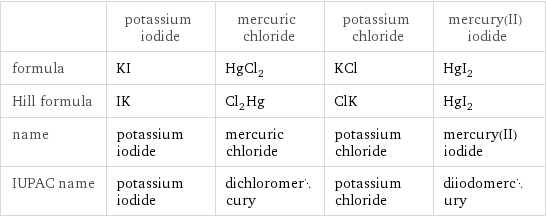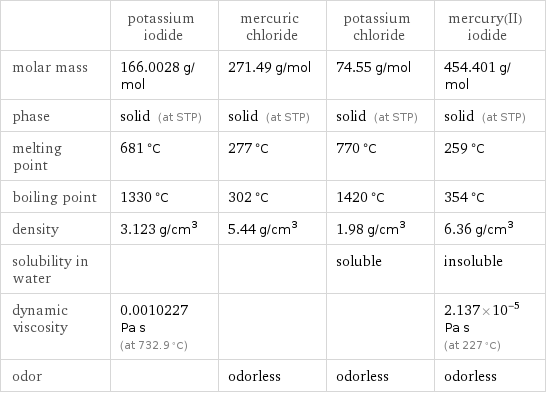Input interpretation

KI potassium iodide + HgCl_2 mercuric chloride ⟶ KCl potassium chloride + HgI_2 mercury(II) iodide
Balanced equation

Balance the chemical equation algebraically: KI + HgCl_2 ⟶ KCl + HgI_2 Add stoichiometric coefficients, c_i, to the reactants and products: c_1 KI + c_2 HgCl_2 ⟶ c_3 KCl + c_4 HgI_2 Set the number of atoms in the reactants equal to the number of atoms in the products for I, K, Cl and Hg: I: | c_1 = 2 c_4 K: | c_1 = c_3 Cl: | 2 c_2 = c_3 Hg: | c_2 = c_4 Since the coefficients are relative quantities and underdetermined, choose a coefficient to set arbitrarily. To keep the coefficients small, the arbitrary value is ordinarily one. For instance, set c_2 = 1 and solve the system of equations for the remaining coefficients: c_1 = 2 c_2 = 1 c_3 = 2 c_4 = 1 Substitute the coefficients into the chemical reaction to obtain the balanced equation: Answer: | | 2 KI + HgCl_2 ⟶ 2 KCl + HgI_2
Structures

+ ⟶ +
Names

potassium iodide + mercuric chloride ⟶ potassium chloride + mercury(II) iodide
Equilibrium constant
![Construct the equilibrium constant, K, expression for: KI + HgCl_2 ⟶ KCl + HgI_2 Plan: • Balance the chemical equation. • Determine the stoichiometric numbers. • Assemble the activity expression for each chemical species. • Use the activity expressions to build the equilibrium constant expression. Write the balanced chemical equation: 2 KI + HgCl_2 ⟶ 2 KCl + HgI_2 Assign stoichiometric numbers, ν_i, using the stoichiometric coefficients, c_i, from the balanced chemical equation in the following manner: ν_i = -c_i for reactants and ν_i = c_i for products: chemical species | c_i | ν_i KI | 2 | -2 HgCl_2 | 1 | -1 KCl | 2 | 2 HgI_2 | 1 | 1 Assemble the activity expressions accounting for the state of matter and ν_i: chemical species | c_i | ν_i | activity expression KI | 2 | -2 | ([KI])^(-2) HgCl_2 | 1 | -1 | ([HgCl2])^(-1) KCl | 2 | 2 | ([KCl])^2 HgI_2 | 1 | 1 | [HgI2] The equilibrium constant symbol in the concentration basis is: K_c Mulitply the activity expressions to arrive at the K_c expression: Answer: | | K_c = ([KI])^(-2) ([HgCl2])^(-1) ([KCl])^2 [HgI2] = (([KCl])^2 [HgI2])/(([KI])^2 [HgCl2])](../image_source/292c5d39f1230b62c204662087f555e0.png)
Construct the equilibrium constant, K, expression for: KI + HgCl_2 ⟶ KCl + HgI_2 Plan: • Balance the chemical equation. • Determine the stoichiometric numbers. • Assemble the activity expression for each chemical species. • Use the activity expressions to build the equilibrium constant expression. Write the balanced chemical equation: 2 KI + HgCl_2 ⟶ 2 KCl + HgI_2 Assign stoichiometric numbers, ν_i, using the stoichiometric coefficients, c_i, from the balanced chemical equation in the following manner: ν_i = -c_i for reactants and ν_i = c_i for products: chemical species | c_i | ν_i KI | 2 | -2 HgCl_2 | 1 | -1 KCl | 2 | 2 HgI_2 | 1 | 1 Assemble the activity expressions accounting for the state of matter and ν_i: chemical species | c_i | ν_i | activity expression KI | 2 | -2 | ([KI])^(-2) HgCl_2 | 1 | -1 | ([HgCl2])^(-1) KCl | 2 | 2 | ([KCl])^2 HgI_2 | 1 | 1 | [HgI2] The equilibrium constant symbol in the concentration basis is: K_c Mulitply the activity expressions to arrive at the K_c expression: Answer: | | K_c = ([KI])^(-2) ([HgCl2])^(-1) ([KCl])^2 [HgI2] = (([KCl])^2 [HgI2])/(([KI])^2 [HgCl2])
Rate of reaction
![Construct the rate of reaction expression for: KI + HgCl_2 ⟶ KCl + HgI_2 Plan: • Balance the chemical equation. • Determine the stoichiometric numbers. • Assemble the rate term for each chemical species. • Write the rate of reaction expression. Write the balanced chemical equation: 2 KI + HgCl_2 ⟶ 2 KCl + HgI_2 Assign stoichiometric numbers, ν_i, using the stoichiometric coefficients, c_i, from the balanced chemical equation in the following manner: ν_i = -c_i for reactants and ν_i = c_i for products: chemical species | c_i | ν_i KI | 2 | -2 HgCl_2 | 1 | -1 KCl | 2 | 2 HgI_2 | 1 | 1 The rate term for each chemical species, B_i, is 1/ν_i(Δ[B_i])/(Δt) where [B_i] is the amount concentration and t is time: chemical species | c_i | ν_i | rate term KI | 2 | -2 | -1/2 (Δ[KI])/(Δt) HgCl_2 | 1 | -1 | -(Δ[HgCl2])/(Δt) KCl | 2 | 2 | 1/2 (Δ[KCl])/(Δt) HgI_2 | 1 | 1 | (Δ[HgI2])/(Δt) (for infinitesimal rate of change, replace Δ with d) Set the rate terms equal to each other to arrive at the rate expression: Answer: | | rate = -1/2 (Δ[KI])/(Δt) = -(Δ[HgCl2])/(Δt) = 1/2 (Δ[KCl])/(Δt) = (Δ[HgI2])/(Δt) (assuming constant volume and no accumulation of intermediates or side products)](../image_source/ddc4f103bcfbdb7fbf128c439f66da96.png)
Construct the rate of reaction expression for: KI + HgCl_2 ⟶ KCl + HgI_2 Plan: • Balance the chemical equation. • Determine the stoichiometric numbers. • Assemble the rate term for each chemical species. • Write the rate of reaction expression. Write the balanced chemical equation: 2 KI + HgCl_2 ⟶ 2 KCl + HgI_2 Assign stoichiometric numbers, ν_i, using the stoichiometric coefficients, c_i, from the balanced chemical equation in the following manner: ν_i = -c_i for reactants and ν_i = c_i for products: chemical species | c_i | ν_i KI | 2 | -2 HgCl_2 | 1 | -1 KCl | 2 | 2 HgI_2 | 1 | 1 The rate term for each chemical species, B_i, is 1/ν_i(Δ[B_i])/(Δt) where [B_i] is the amount concentration and t is time: chemical species | c_i | ν_i | rate term KI | 2 | -2 | -1/2 (Δ[KI])/(Δt) HgCl_2 | 1 | -1 | -(Δ[HgCl2])/(Δt) KCl | 2 | 2 | 1/2 (Δ[KCl])/(Δt) HgI_2 | 1 | 1 | (Δ[HgI2])/(Δt) (for infinitesimal rate of change, replace Δ with d) Set the rate terms equal to each other to arrive at the rate expression: Answer: | | rate = -1/2 (Δ[KI])/(Δt) = -(Δ[HgCl2])/(Δt) = 1/2 (Δ[KCl])/(Δt) = (Δ[HgI2])/(Δt) (assuming constant volume and no accumulation of intermediates or side products)
Chemical names and formulas

| potassium iodide | mercuric chloride | potassium chloride | mercury(II) iodide formula | KI | HgCl_2 | KCl | HgI_2 Hill formula | IK | Cl_2Hg | ClK | HgI_2 name | potassium iodide | mercuric chloride | potassium chloride | mercury(II) iodide IUPAC name | potassium iodide | dichloromercury | potassium chloride | diiodomercury
Substance properties

| potassium iodide | mercuric chloride | potassium chloride | mercury(II) iodide molar mass | 166.0028 g/mol | 271.49 g/mol | 74.55 g/mol | 454.401 g/mol phase | solid (at STP) | solid (at STP) | solid (at STP) | solid (at STP) melting point | 681 °C | 277 °C | 770 °C | 259 °C boiling point | 1330 °C | 302 °C | 1420 °C | 354 °C density | 3.123 g/cm^3 | 5.44 g/cm^3 | 1.98 g/cm^3 | 6.36 g/cm^3 solubility in water | | | soluble | insoluble dynamic viscosity | 0.0010227 Pa s (at 732.9 °C) | | | 2.137×10^-5 Pa s (at 227 °C) odor | | odorless | odorless | odorless
Units
